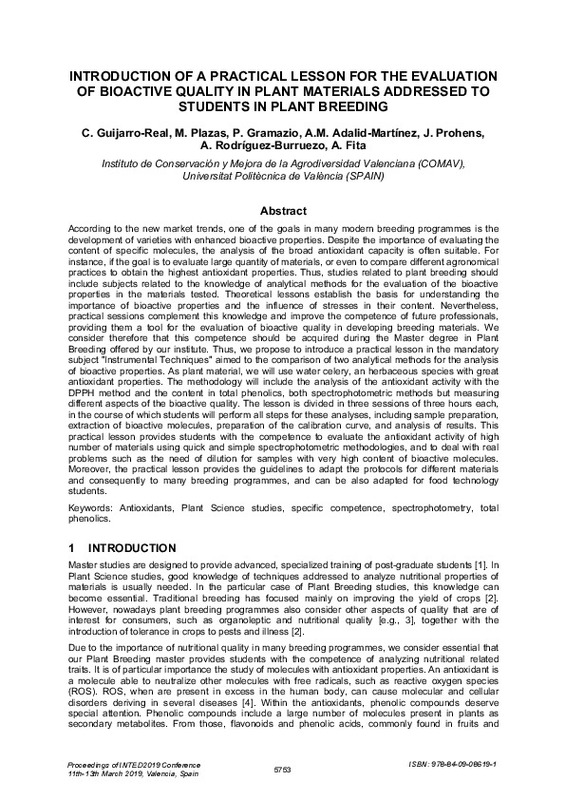|
Resumen:
|
[EN] According to the new market trends, one of the goals in many modern breeding programmes is the development of varieties with enhanced bioactive properties. Despite the importance of evaluating the content of specific ...[+]
[EN] According to the new market trends, one of the goals in many modern breeding programmes is the development of varieties with enhanced bioactive properties. Despite the importance of evaluating the content of specific molecules, the analysis of the broad antioxidant capacity is often suitable. For instance, if the goal is to evaluate large quantity of materials, or even to compare different agronomical practices to obtain the highest antioxidant properties. Thus, studies related to plant breeding should include subjects related to the knowledge of analytical methods for the evaluation of the bioactive properties in the materials tested. Theoretical lessons establish the basis for understanding the importance of bioactive properties and the influence of stresses in their content. Nevertheless, practical sessions complement this knowledge and improve the competence of future professionals, providing them a tool for the evaluation of bioactive quality in developing breeding materials. We consider therefore that this competence should be acquired during the Master degree in Plant Breeding offered by our institute. Thus, we propose to introduce a practical lesson in the mandatory subject "Instrumental Techniques" aimed to the comparison of two analytical methods for the analysis of bioactive properties. As plant material, we will use water celery, an herbaceous species with great antioxidant properties. The methodology will include the analysis of the antioxidant activity with the DPPH method and the content in total phenolics, both spectrophotometric methods but measuring different aspects of the bioactive quality. The lesson is divided in three sessions of three hours each, in the course of which students will perform all steps for these analyses, including sample preparation, extraction of bioactive molecules, preparation of the calibration curve, and analysis of results. This practical lesson provides students with the competence to evaluate the antioxidant activity of high number of materials using quick and simple spectrophotometric methodologies, and to deal with real problems such as the need of dilution for samples with very high content of bioactive molecules. Moreover, the practical lesson provides the guidelines to adapt the protocols for different materials and consequently to many breeding programmes, and can be also adapted for food technology students.
[-]
|
|
Agradecimientos:
|
Carla Guijarro-Real is grateful to the Ministerio de Educación, Cultura y Deporte of Spain (MECD) for
a predoctoral FPU grant (FPU14-06798). Mariola Plazas is grateful to Generalitat Valenciana and
Fondo Social Europeo for ...[+]
Carla Guijarro-Real is grateful to the Ministerio de Educación, Cultura y Deporte of Spain (MECD) for
a predoctoral FPU grant (FPU14-06798). Mariola Plazas is grateful to Generalitat Valenciana and
Fondo Social Europeo for a post-doctoral grant (APOSTD/2018/014). Pietro Gramazio is grateful to
Universitat Politècnica de València for a post-doctoral contract (PAID-10-18) within the Programa de
Ayudas de Investigación y Desarrollo initiative. Ana M Adalid-Martínez is grateful to the Ministerio de
Ciencia, Innovación y Universidad of Spain for its support with a post-doctoral contract (PTA2015-
11502-I) within the Subprograma Personal Técnico de Apoyo initiative.
[-]
|









